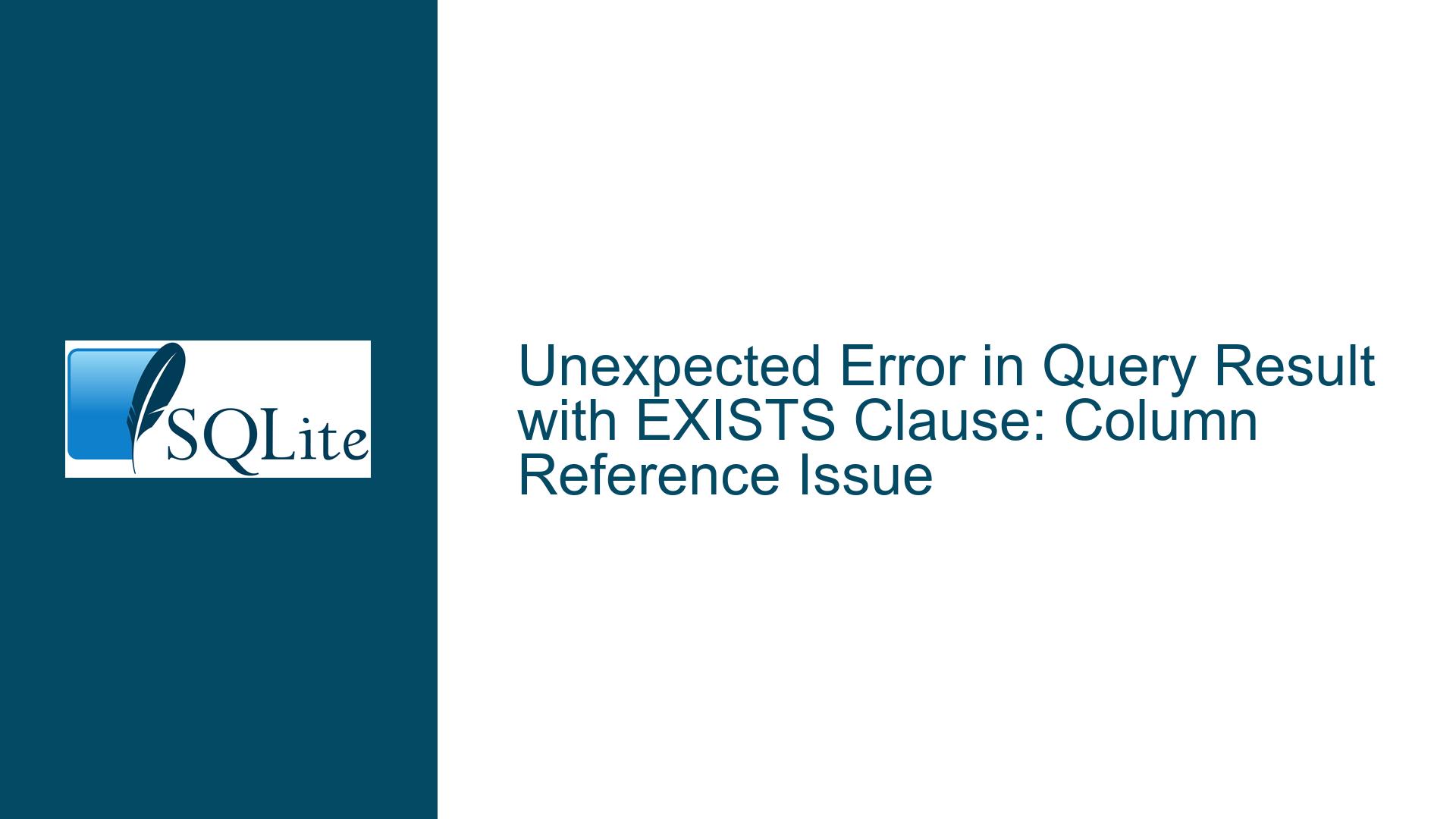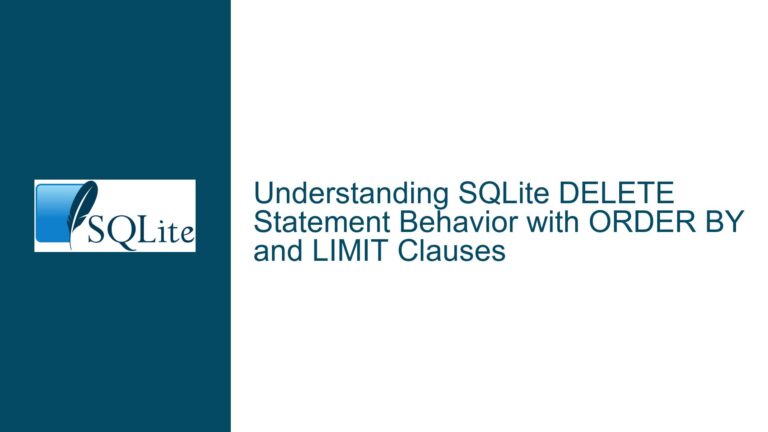Unexpected Error in Query Result with EXISTS Clause: Column Reference Issue
Issue Overview: Misunderstanding of Column Scope in EXISTS Clause
The core issue revolves around a misunderstanding of column scope and table references when using the EXISTS clause in SQLite. The query in question attempts to use a column from an outer table (v1 from v0) within a subquery that is scoped to an inner table (v2). However, the subquery does not explicitly reference the outer table, leading to an error because the column v1 is not recognized within the context of the subquery. This is a common pitfall when working with correlated subqueries, where the relationship between the outer and inner tables is not properly established.
The query structure is as follows:
CREATE TABLE v0 ( v1 INTEGER);
INSERT INTO v0 VALUES ( 100 ), ( 1 );
CREATE TABLE v2 ( v3 INTEGER PRIMARY KEY );
INSERT INTO v2 VALUES ( 100 );
SELECT v3 FROM v2 WHERE EXISTS ( SELECT v3 WHERE v3 = v1 );
The error message Error: no such column: v1 indicates that the column v1 is not found within the scope of the subquery. This is because the subquery is only aware of the columns in the v2 table, and v1 is not one of them. The expectation was that the query would return the value 100 from the v2 table, but the error prevents the query from executing successfully.
Possible Causes: Scoping and Table Reference Issues
The primary cause of this issue is the lack of proper scoping and table references in the subquery. In SQLite, when a subquery is used in an EXISTS clause, it must explicitly reference the columns from the outer table if it needs to use them. This is because the subquery operates within its own scope, and without a direct reference to the outer table, it cannot access the columns from that table.
In the given query, the subquery SELECT v3 WHERE v3 = v1 does not reference the outer table v0 at all. The column v1 is part of the v0 table, but the subquery is only aware of the v2 table. As a result, SQLite cannot resolve the column v1 within the context of the subquery, leading to the error.
Another potential cause is the misunderstanding of how the EXISTS clause works. The EXISTS clause is used to check for the existence of rows that meet a certain condition. In this case, the condition is that there should be a row in the v2 table where v3 equals v1. However, without a proper reference to the v0 table, the condition cannot be evaluated correctly.
Troubleshooting Steps, Solutions & Fixes: Properly Referencing Outer Tables in Subqueries
To resolve this issue, the subquery must be modified to explicitly reference the outer table v0. This can be done by using a correlated subquery, where the subquery references columns from the outer query. In this case, the subquery should reference the v1 column from the v0 table.
The corrected query would look like this:
SELECT v3 FROM v2 WHERE EXISTS ( SELECT 1 FROM v0 WHERE v3 = v1 );
In this query, the subquery SELECT 1 FROM v0 WHERE v3 = v1 explicitly references the v0 table, allowing it to access the v1 column. The EXISTS clause then checks if there is any row in the v0 table where v3 equals v1. If such a row exists, the EXISTS clause returns TRUE, and the corresponding row from the v2 table is included in the result set.
Another approach to solving this issue is to use a JOIN instead of an EXISTS clause. A JOIN combines rows from two or more tables based on a related column between them. In this case, a JOIN can be used to combine rows from the v2 and v0 tables where v3 equals v1.
The JOIN query would look like this:
SELECT v3 FROM v2 JOIN v0 ON v3 = v1;
This query joins the v2 and v0 tables on the condition that v3 equals v1. The result is a single row with v3=100, which matches the expected output.
Both of these solutions address the core issue by ensuring that the column v1 is properly referenced within the context of the query. The first solution uses a correlated subquery to explicitly reference the outer table, while the second solution uses a JOIN to combine the tables based on the related column.
In addition to these solutions, it is important to understand the underlying principles of scoping and table references in SQLite. When working with subqueries, it is crucial to ensure that all columns are properly referenced within their respective scopes. This includes explicitly referencing outer tables in correlated subqueries and ensuring that all columns used in conditions are available within the context of the query.
Furthermore, it is important to understand the differences between EXISTS and JOIN and when to use each. The EXISTS clause is useful for checking the existence of rows that meet a certain condition, while a JOIN is useful for combining rows from multiple tables based on a related column. Choosing the right approach depends on the specific requirements of the query and the desired outcome.
In conclusion, the issue of the unexpected error in the query result with the EXISTS clause is caused by a misunderstanding of column scope and table references. By properly referencing the outer table in the subquery or using a JOIN to combine the tables, the issue can be resolved, and the expected result can be achieved. Understanding the principles of scoping and table references in SQLite is essential for writing effective and error-free queries.






